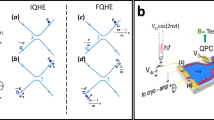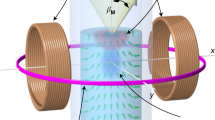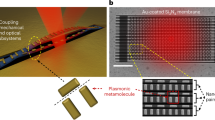Abstract
Time reflection and refraction are temporal analogies of the spatial boundary effects derived from Fermat’s principle. They occur when classical waves strike a time boundary where an abrupt change in the properties of the medium is introduced. The main features of time-reflected and time-refracted waves are the shift in frequency and conservation of momentum, which offer a new degree of freedom for steering extreme waves and controlling the phases of matter. The concept was originally proposed for manipulating optical waves more than five decades ago. However, due to the extreme challenges in the ultrafast engineering of optical materials, the experimental realization of the time boundary effects remains elusive. Here we introduce a time boundary into a momentum lattice of ultracold atoms and simultaneously demonstrate time reflection and refraction experimentally. Through launching a Gaussian-superposed state into the Su–Schrieffer–Heeger atomic chain, we observe the time-reflected and time-refracted waves when the input state strikes a time boundary. Furthermore, we detect a transition from time reflection/refraction to localization with increasing strength of disorder and show that the time boundary effects are robust against considerable disorder. Our work opens a new avenue for the future exploration of time boundaries and spatiotemporal lattices, as well as their interplay with non-Hermiticity and many-body interactions.
This is a preview of subscription content, access via your institution
Access options
Access Nature and 54 other Nature Portfolio journals
Get Nature+, our best-value online-access subscription
$29.99 / 30 days
cancel any time
Subscribe to this journal
Receive 12 print issues and online access
$209.00 per year
only $17.42 per issue
Buy this article
- Purchase on Springer Link
- Instant access to full article PDF
Prices may be subject to local taxes which are calculated during checkout




Similar content being viewed by others
Data availability
All the data supporting the findings of this study are available within this Article and its Supplementary Information. Any additional information can be obtained from the corresponding authors on reasonable request. Source data are provided with this paper.
References
Akhmanov, A. S. S. & Chirkin, A. Nonstationary phenomena and space-time analogy in nonlinear optics. Sov. Phys. JETP 28, 748–757 (1969).
Kolner, B. Space-time duality and the theory of temporal imaging. IEEE J. Quantum Electron. 30, 1951–1963 (1994).
Mendonca, J. T. & Shukla, P. K. Time refraction and time reflection: two basic concepts. Phys. Scr. 65, 160–163 (2002).
Xiao, Y. Z., Maywar, D. N. & Agrawal, G. P. Reflection and transmission of electromagnetic waves at a temporal boundary. Opt. Lett. 39, 574–577 (2014).
Vezzoli, S. et al. Optical time reversal from time-dependent epsilon-near-zero media. Phys. Rev. Lett. 120, 043902 (2018).
Zhou, Y. et al. Broadband frequency translation through time refraction in an epsilon-near-zero material. Nat. Commun. 11, 2180 (2020).
Lustig, E. et al. Towards photonic time-crystals: observation of a femtosecond time-boundary in the refractive index. In 2021 Conference on Lasers and Electro-Optics (CLEO) 1–2 (IEEE, 2021).
Dikopoltsev, A. et al. Light emission by free electrons in photonic time-crystals. Proc. Natl Acad. Sci. USA 119, e2119705119 (2022).
Lustig, E., Sharabi, Y. & Segev, M. Topological aspects of photonic time crystals. Optica 5, 1390–1395 (2018).
Giergiel, K., Dauphin, A., Lewenstein, M., Zakrzewski, J. & Sacha, K. Topological time crystals. New J. Phys. 21, 052003 (2019).
Sharabi, Y., Lustig, E. & Segev, M. Disordered photonic time crystals. Phys. Rev. Lett. 126, 163902 (2021).
Sharabi, Y., Dikopoltsev, A., Lustig, E., Lumer, Y. & Segev, M. Spatiotemporal photonic crystals. Optica 9, 585–592 (2022).
Peng, Y. Topological space-time crystal. Phys. Rev. Lett. 128, 186802 (2022).
Yin, S., Galiffi, E. & Alú, A. Floquet metamaterials. eLight 2, 8 (2022).
Weitenberg, C. & Simonet, J. Tailoring quantum gases by Floquet engineering. Nat. Phys. 17, 1342–1348 (2021).
Lustig, E. et al. Towards photonic time-crystals: observation of a femtosecond time-boundary in the refractive index. In Conference on Lasers and Electro-Optics FF2H.1 (Optica Publishing Group, 2021).
Olivia, A. D., Long, Y., Wang, K. & Fan, S. Time reflection and refraction in synthetic frequency dimension. Phys. Rev. Res. 5, L012046 (2023).
Bacot, V., Labousse, M., Eddi, A., Fink, M. & Fort, E. Time reversal and holography with spacetime transformations. Nat. Phys. 12, 972–977 (2016).
Moussa, H. et al. Observation of temporal reflections and broadband frequency translations at photonic time interfaces. Nat. Phys. 19, 863–868 (2023).
Bloch, I., Dalibard, J. & Zwerger, W. Many-body physics with ultracold gases. Rev. Mod. Phys. 80, 885–964 (2008).
Bloch, I., Dalibard, J. & Nascimbene, S. Quantum simulations with ultracold quantum gases. Nat. Phys. 8, 267–276 (2012).
Gross, C. & Bloch, I. Quantum simulations with ultracold atoms in optical lattices. Science 357, 995–1001 (2017).
Schafer, F., Fukuhara, T., Sugawa, S., Takasu, Y. & Takahashi, Y. Tools for quantum simulation with ultracold atoms in optical lattices. Nat. Rev. Phys. 2, 411–425 (2020).
Zhai, H. Degenerate quantum gases with spin-orbit coupling: a review. Rep. Prog. Phys. 78, 026001 (2015).
Goldman, N., Budich, J. C. & Zoller, P. Topological quantum matter with ultracold gases in optical lattices. Nat. Phys. 12, 639–645 (2016).
Cooper, N. R., Dalibard, J. & Spielman, I. B. Topological bands for ultracold atoms. Rev. Mod. Phys. 91, 015005 (2019).
Jotzu, G. et al. Experimental realization of the topological Haldane model with ultracold fermions. Nature 515, 237–240 (2014).
Mancini, M. et al. Observation of chiral edge states with neutral fermions in synthetic Hall ribbons. Science 349, 1510–1513 (2015).
Stuhl, B. K., Lu, H. I., Aycock, L. M., Genkina, D. & Spielman, I. B. Visualizing edge states with an atomic Bose gas in the quantum Hall regime. Science 349, 1514–1518 (2015).
Folling, S. et al. Direct observation of second-order atom tunnelling. Nature 448, 1029–1032 (2007).
Atala, M. et al. Direct measurement of the Zak phase in topological Bloch bands. Nat. Phys. 9, 795–800 (2013).
Meier, E. J., An, F. A. & Gadway, B. Observation of the topological soliton state in the Su-Schrieffer-Heeger model. Nat. Commun. 7, 13986 (2016).
Xie, D., Gou, W., Xiao, T., Gadway, B. & Yan, B. Topological characterizations of an extended Su-Schrieffer-Heeger model. npj Quantum Inf. 5, 55 (2019).
Yao, S. & Wang, Z. Edge states and topological invariants of non-Hermitian systems. Phys. Rev. Lett. 121, 086803 (2018).
Bergholtz, E. J., Budich, J. C., & Kunst, F. K. Exceptional topology of non-Hermitian systems. Rev. Mod. Phys. 93, 015005 (2021).
Liang, Q. et al. Dynamic signatures of non-Hermitian skin effect and topology in ultracold atoms. Phys. Rev. Lett. 129, 070401 (2022).
Gou, W. et al. Tunable nonreciprocal quantum transport through a dissipative Aharonov-Bohm ring in ultracold atoms. Phys. Rev. Lett. 124, 070402 (2020).
Meier, E. J., An, F. A. & Gadway, B. Atom-optics simulator of lattice transport phenomena. Phys. Rev. A 93, 051602 (2016).
Meier, E. J. et al. Observation of the topological Anderson insulator in disordered atomic wires. Science 362, 929–933 (2018).
Sacha, K. Anderson localization and Mott insulator phase in the time domain. Sci. Rep. 5, 10787 (2015).
Mierzejewski, M., Giergiel, K. & Sacha, K. Many-body localization caused by temporal disorder. Phys. Rev B 96, 140201 (2017).
Abanin, D. A., Altman, E., Bloch, I. & Serbyn, M. Colloquium: many-body localization, thermalization, and entanglement. Rev. Mod. Phys. 91, 021001 (2019).
Randall, J. et al. Many-body-localized discrete time crystal with a programmable spin-based quantum simulator. Science 374, abk0603 (2021).
Plansinis, B. W., Donaldson, W. R. & Agrawal, G. P. What is the temporal analog of reflection and refraction of optical beams. Phys. Rev. Lett. 115, 183901 (2015).
Xie, D., Wang, D., Gou, W., Bu, W. & Yan, B. Fast production of rubidium Bose-Einstein condensate in a dimple trap. J. Opt. Soc. Am. B 35, 500–503 (2018).
Chen, T. et al. Quantum Zeno effects across a parity-time symmetry breaking transition in atomic momentum space. npj Quantum Inf. 7, 78 (2021).
Li, H. et al. Aharonov-Bohm caging and inverse Anderson transition in ultracold atoms. Phys. Rev. Lett. 129, 220403 (2022).
Raitzsch, U. et al. Echo experiments in a strongly interacting Rydberg gas. Phys. Rev. Lett. 100, 013002 (2008).
Yan, B., Cincio, L. & Zurek, W. H. Information scrambling and Loschmidt echo. Phys. Rev. Lett. 124, 160603 (2020).
An, F. A. et al. Interactions and mobility edges: observing the generalized Aubry-André model. Phys. Rev. Lett. 126, 040603 (2021).
Yao, H., Khoudli, H., Bresque, L. & Sanchez-Palencia, L. Critical behavior and fractality in shallow one-dimensional quasiperiodic potentials. Phys. Rev. Lett. 123, 070405 (2019).
Liu, F., Ghosh, S. & Chong, Y. D. Localization and adiabatic pumping in a generalized Aubry-André-Harper model. Phys. Rev. B 91, 014108 (2015).
Iyer, S., Oganesyan, V., Refael, G. & Huse, D. A. Many-body localization in a quasiperiodic system. Phys. Rev. B 87, 134202 (2013).
Lyubarov, M. et al. Amplified emission and lasing in photonic time crystals. Science 377, 425–428 (2022).
Heugel, T. L., Oscity, M., Eichler, A., Zilberberg, O. & Chitra, R. Classical many-body time crystals. Phys. Rev. Lett. 123, 124301 (2019).
Acknowledgements
We acknowledge funding support from the National Key Research and Development Program of China under grant no. 2022YFA1404203; the National Natural Science Foundation of China under grant nos. U21A20437, 12074337, and 12174339; Zhejiang Provincial Natural Science Foundation of China under grant nos. LR21A040002 and LR23A040003; Zhejiang Provincial Plan for Science and Technology grant no. 2020C01019; the Fundamental Research Funds for the Central Universities under grant no. 2021FZZX001-02; the Excellent Youth Science Foundation Project (Overseas); and China Postdoctoral Science Foundation under grant no. 2023M733122.
Author information
Authors and Affiliations
Contributions
Z.Y. and B.Y. conceived and designed the experiments. Z.D., H.L. and Q.L. performed the experiments. T.W. and H.L. conducted the theoretical modelling and simulations. Z.Y. and B.Y. supervised this project and wrote the paper, with input from all authors.
Corresponding authors
Ethics declarations
Competing interests
The authors declare no competing interests.
Peer review
Peer review information
Nature Photonics thanks Peter Hannaford and the other, anonymous, reviewer(s) for their contribution to the peer review of this paper.
Additional information
Publisher’s note Springer Nature remains neutral with regard to jurisdictional claims in published maps and institutional affiliations.
Supplementary information
Supplementary Information
Supplementary Figs. 1–8 and Sections I–VII.
Source data
Source Data Fig. 1
Numerical data used to generate Fig. 1c.
Source Data Fig. 2
Experimental data used to generate Fig. 2b,c.
Source Data Fig. 3
Experimental data used to generate Fig. 3b.
Source Data Fig. 4
Experimental data used to generate Fig. 4b.
Rights and permissions
Springer Nature or its licensor (e.g. a society or other partner) holds exclusive rights to this article under a publishing agreement with the author(s) or other rightsholder(s); author self-archiving of the accepted manuscript version of this article is solely governed by the terms of such publishing agreement and applicable law.
About this article
Cite this article
Dong, Z., Li, H., Wan, T. et al. Quantum time reflection and refraction of ultracold atoms. Nat. Photon. 18, 68–73 (2024). https://doi.org/10.1038/s41566-023-01290-1
Received:
Accepted:
Published:
Issue Date:
DOI: https://doi.org/10.1038/s41566-023-01290-1
This article is cited by
-
Reflection and refraction at a time boundary
Nature Photonics (2024)



